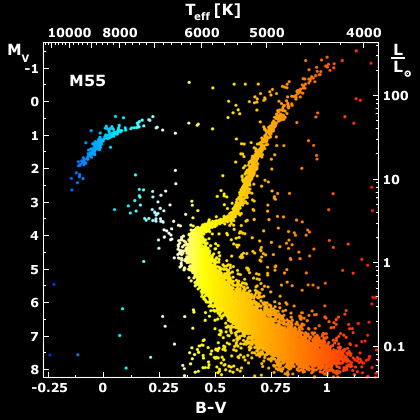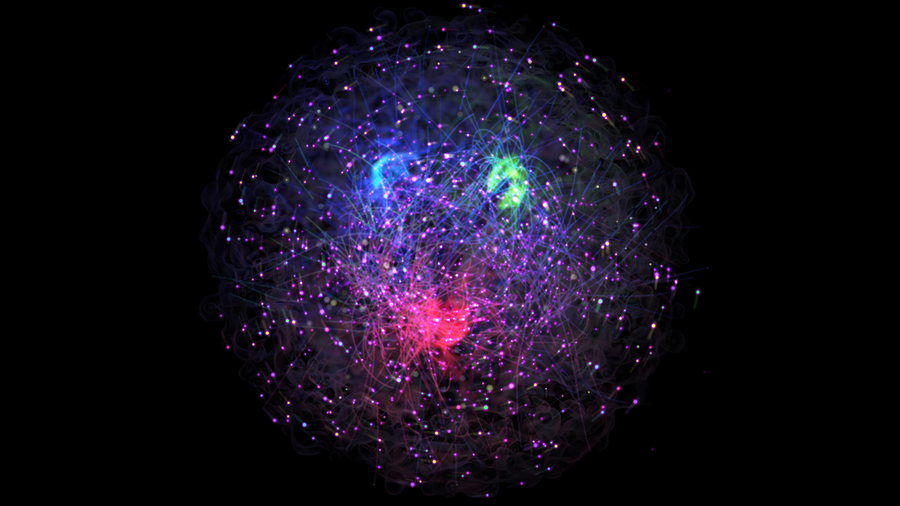VictorBorun wrote: ↑Thu Mar 16, 2023 4:23 am
I thought you can't very well see both red giants and old under-Suns in the same exposure at the same distance?
And how come there are thousands of red giants — they mostly should long since had gone white dwarfs… or are they being created in the thick of the cluster from star to star mergers?
The red giants in Omega Centauri are low-mass stars. Apart from the likely presence of blue straggler stars (or post-blue stragglers, which have evolved away from the blue stage and become red giants themselves), all stars in Omega Centauri are probably less massive than the Sun. That is because all the stars in Omega Centauri that started out more massive than the Sun have already turned into white dwarfs, or, just possibly, into neutron stars.
Wikipedia wrote:
Omega Centauri is
very different from most other galactic globular clusters to the extent that it is thought to have originated as
the core remnant of a disrupted dwarf galaxy.
Bright central part of M33, perhaps slightly similar to Omega Centauri.
M33 doesn't qualify as a dwarf galaxy, because it is too big. Still it is considerably smaller than the Milky Way. You can see that its central part is brighter than the rest of the galaxy and yellowish in color. This means that the stellar density is higher here than in other parts of M33, and also the stars residing here are typically old and yellow.
The galaxy whose core became Omega Centauri may have been slightly similar to M33, but smaller and a lot more metal-poor.
Because the stars of Omega Centauri are indeed very metal-poor, which is to say they contain extremely few elements other than hydrogen and helium. This also means that for a given mass, energy generated in the core of the star will pass a bit more unhindered through the thick surrounding gaseous layers of the star and emerge at the photosphere (the visible "surface" of the star) a bit
bluer in metal-poor stars than in metal-rich ones (like the Sun). That is because the photon will lose a bit less energy during its passage through the star if the star is metal-poor (i.e., if it contains extremely few elements other than hydrogen and helium).
The energetic photon's journey from the core to the photosphere of a star is called a "random walk".
In a metal-poor globular cluster, the overall color of the cluster is "shifted toward the blue". We may be fooled to think that individual blue stars that we see in a globular cluster are massive, because we associate blue stars with high mass. But in a globular cluster, the reasonably bright blue stars are almost always "horizontal branch stars", which is an evolutionary stage where evolved (giant) stars become blue if they are metal-poor and yellow if they are metal-rich. In globular clusters, these blue stars are less massive than the Sun.
These are the different populations of stars inside a globular cluster:
Main sequence stars are fusing hydrogen to helium in their cores, like the Sun. Well, all main sequence stars in old globular clusters like Omega Centauri are less massive than the Sun! They may be the same color as the Sun, so that we are deceived to think that they are the same mass as the Sun, but they are not. If they had been metal-rich stars like the Sun, then all the stars that are still on the main sequence in old globular clusters would have looked more orange than the Sun, because they are all less massive than the Sun!
Consider RR Lyrae stars, which belong to the horizontal branch of globular clusters. These stars are only about half the mass of the Sun, yet they are 40-50 times brighter than the Sun!

Wikipedia wrote about RR Lyrae variables:
They are pulsating horizontal branch stars of spectral class A or F, with a mass of around half the Sun's. They are thought to have shed mass during the red-giant branch phase, and were once stars at around 0.8 solar masses.
Wikipedia wrote about RR Lyrae variables:
RR Lyraes are old, relatively low mass, Population II stars, in common with W Virginis and BL Herculis variables, the type II Cepheids. (...) The average absolute magnitude of an RR Lyrae star is about +0.75, only 40 or 50 times brighter than the Sun.
So the RR Lyrae stars that we see in globular clusters started out with a mass of about 0.8 solar masses! They would have started out as rather faint K-type main sequence stars just a little more massive than the components of binary star
61 Cygni if they had been metal-rich! And yet they are now 40-50 times brighter than the Sun!
This is my point. All stars in globular clusters (with perhaps an extremely few rare exceptions) are less massive than the Sun. After billions and billions of years, these low-mass stars slowly start evolving into gianthood. That is why we see red giants in globular clusters. These red giants are reasonably bright, perhaps, oh, 300 times brighter than the Sun? 500 times brighter? But they are all less massive than the Sun, perhaps only half as massive as the Sun!
So the red giants of globular clusters started out as low-mass main sequence stars no more massive than the Sun (and probably less massive), and after more than 10 billion years, they have used up the hydrogen in their cores and evolved into red giants.
Does that mean that there were never any really massive stars in globular clusters?

Of course there were! Duh!!! But they used up their core hydrogen very quickly and ran through all their evolutionary stages and exploded as supernovas! And the stars that were not massive enough to go supernova, but still more massive than the Sun, have all turned into white dwarfs.
Except that Omega Centauri may have been different. Omega Centauri is the core of a disrupted dwarf galaxy, and I'm not absolutely convinced that cores of dwarf galaxies ever contained a lot of massive stars. But who knows?
This is my point. Omega Centauri is still going strong.
But he
is an old man!!!
Ann
 Millions of Stars in Omega Centauri
Millions of Stars in Omega Centauri













